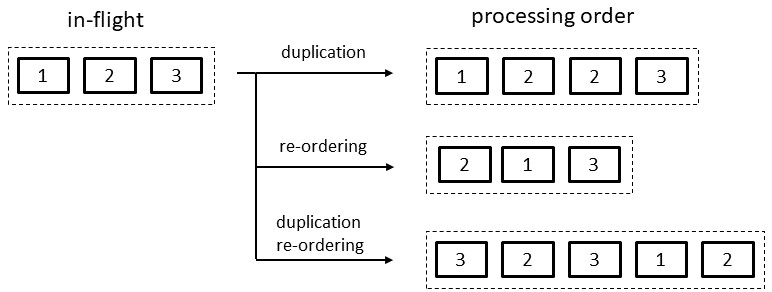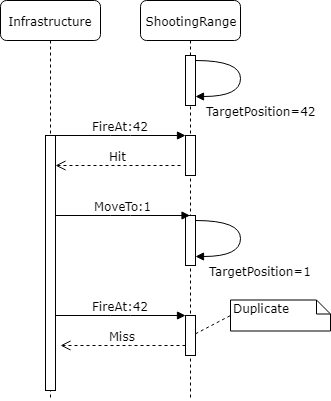Consistent messaging
by Tomek Masternak, Szymon PobiegaModern messaging infrastructures offer delivery guarantees that make it non-trivial to build distributed systems. Robust solutions require a good understanding of what can and can’t happen and how that affects business level behavior.
This post looks at the main challenges from the system consistency perspective and sketches possible solutions.
A system
We will assume that systems in focus consist of endpoints, each owning a distinct piece of state. Every endpoint processes input messages, modifying internal state and producing output messages. All endpoints communicate using persistent messaging with at-least-once delivery guarantee. Finally, we assume no messages can be lost.
This covers a pretty wide range of systems. Most notably service-based architectures build on top of the modern messaging infrastructure - both on-premise and in the cloud 1.

An endpoint
With at-least-once delivery, any in-flight message gets delivered possibly multiple times. This is a direct consequence of communication protocols used as any message will be re-delivered until acknowledged by the receiver. For the same reasons, duplicates get created by message producers.
Apart from being duplicated, in-flight messages can get re-ordered. There are many reasons for this to happen 2 one of the most obvious being message re-delivery mechanism. If a delivery fails, a message is available for reprocessing only after some back-off period. Any other in-flight message can be processed during that time causing the respective order of those messages to change.
When combined, duplication and re-ordering can result, at the receiver side, in many different processing sequences. The only guarantee is that the resulting sequence contains at least one copy of each message sent.

Sample duplication and re-ordering scenarios
The system
Let’s look at a system that models a moving target shooting range to see the practical consequences of this behavior.
We will start with a single ShootingRange endpoint which stores shooting target’s location { int: TargetPosition } and processes FireAt : { int: Position } messages.
Whenever FireAt message gets processed the endpoint produces either Hit or Missed event to indicate the result:
void Handle(FireAt message)
{
if(this.TargetPosition == message.Position)
{
Publish(new Hit());
}
else
{
Publish(new Missed());
}
}
Duplicates
Let’s extend the system with a second LeaderBoard endpoint that’s responsible for storing the number of target hits that the player made. The endpoint processes Hit messages generated by the ShootingRange:
void Handle(Hit message)
{
this.NumberOfHits++;
}
It’s easy to notice that this will break when Hit messages get duplicated. When LeaderBoard receives a Hit message it has no way to tell if there’s been a new hit or if it’s just duplicate of some other Hit message already processed.
The only way to cope with duplicates is by making sure we can test message equality at the business level. This can be achieved by modeling messages as immutable facts or intents with unique identity rather than values 3.
If we extend FireAt message with AttemptId property (unique for each attempt the player makes) we can later use it as an identifier for the Hit event. With that in place, LeaderBoard logic becomes:
void Handle(Hit message)
{
if(this.Hits.Contains(message.AttemptId))
{
return;
}
this.Hits.Add(message.AttemptId);
this.NumberOfHits++;
}
In short, business-level identifiers are a must to cope with duplicates.
Re-ordering
Let’s add another moving piece to our system - GameScenario endpoint that changes the current position of the moving target by sending MoveTarget messages to the ShootingRange endpoint. ShootingRange logic now becomes:
void Handle(MoveTarget message)
{
this.TargetPosition = message.Position;
}
void Handle(FireAt message)
{
if(this.TargetPosition == message.Position)
{
Publish(new Hit { AttemptId = message.AttemptId });
}
else
{
Publish(new Missed { AttemptId = message.AttemptId });
}
}
Let’s analyze one possible processing scenario that incudes FireAt and MoveTarget messages. We begin with TargetPosition equal to 42, the player sends FireAt : { Position: 42 } and GameScenario sends MoveTarget : {Position: 1}. Due to duplication and re-ordering FireAt gets processed first followed by MoveTarget and finally FireAt duplicate.

An 'alternative worlds' scenario
This results with ShootingRange publishing two events - Hit and Missed, both for the same FireAt message.
We ended up with two messages representing two contradictory facts about the same attempt. It’s not the case of an unexpected end-state e.g. with an attempt resulting in a miss when we expected a hit. It’s far worse than that! We ended up in a state which indicates that two logically exclusive alternatives occurred. A state which is simply corrupted.
Consistency
We know things went bad but what was the root cause? It all boils down to the fact that FireAt duplicate was processed using a different version of ShootingRage state than the first time. Initially, TargetPosition was 42 and changed to 1 before the duplicate arrived. That, in turn, resulted in “alternative-worlds” scenario where the attempt both missed and hit the target.
Duplicates and re-ordering are the reality we operate in and can’t change. What we can do though, is to ensure that once a message gets processed all duplicates result in consistent observable side-effects i.e. messages produced. In our example, we need a guarantee that processing FireAt duplicate results either in no messages published or in an exact copy of the first Hit event. Producing duplicates is fine as those have to be handled either way.
More generally, we want an endpoint to produce observable side-effects equivalent to some execution in which each logical message gets processed exactly-once. Equivalent meaning that it’s indistinguishable from the perspective of any other endpoint.
Exactly-once
There are many possible implementations of exactly-once behavior. Every with its own set of constraints and trade-offs. As usual, which approach is the best fit depends on the context and concrete requirements.
Business logic level
It’s possible to make the business logic responsible for producing consistent behavior. In such a case, the business rules have to be extended or tweaked to make sure duplicates and re-ordering are properly handled.
State-based
Any operation performed on the same input (state) results in the same output (messages), no matter how many times executed. If for any duplicate we could get a version of the state as it was when the first processing happened than we could re-run the handling logic and be sure to get consistent output.
Side-effects based
Alternatively, we could capture the side-effects instead of the state used to produce them. What gets captured in such an approach are not the historical versions of the state but rather messages that got produced when processing a given message.
With that in place, whenever a message arrives we can query the side-effects store to see if that’s a duplicate. If so, the business logic invocation can be skipped and the stored messages published right away.
Summary
There are non-trivial challenges that designers need to overcome when building message-based systems. In this post, we’ve seen what kind of consistency problems may arise when message duplication and re-ordering are not handled with care. Finally, we sketched some of the possible ways to ensure consistent business behavior.
That being said we only scratched the surface. There are many architectural and technical aspects that we did not consider tough: What can be done generically, independent of the business logic? Do we require any guarantees from the storage used by the endpoint? Exactly, how much extra data do we need to store?
Those are all interesting topics that we will be covered in the follow-up posts.
- RabbitMQ, ASQ, Azure Service Bus, SQS are just a few examples [return]
- Great description of ordered delivery challenges can be found in Kevin’s post. The post focuses on SQS but drives to conclusions applicable to other messaging solutions out there. [return]
- Similarly to Value Objects and Entities in Domain-Driven Design [return]